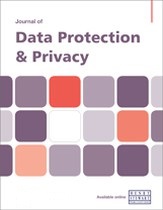Is distributed ledger technology built for personal data?
Abstract
Some of the appealing characteristics of distributed ledger technology (DLT), which blockchain is a type of, include guaranteed integrity, disintermediation and distributed resilience. These characteristics give rise to the possible consequences of immutability, unclear ownership, universal accessibility and transborder storage. These consequences have the potential to contravene data protection principles of Purpose Specification, Use Limitation, Data Quality, Individual Participation and Transborder Data Flow. This paper endeavours to clarify the various types of DLTs, how they work, why they exhibit the depicted characteristics and the consequences. Using the universal privacy principles developed by the Organisation of Economic Cooperation and Development (OECD), this paper then describes how each of the consequence causes concerns for privacy protection and how attempts are being made to address them in the design and implementation of various applications of blockchain and DLT, and indicates where further research and best-practice developments lie.
The full article is available to subscribers to the journal.
Author's Biography
Henry Chang is an adjunct associate professor with the Department of Law, University of Hong Kong. Dr Chang was the IT advisor at the Office of the Privacy Commissioner for Personal Data, Hong Kong, advising the Commissioner and his office on the privacy impact of technological developments and also on the investigation of complex cases that involved ICT. He was the founding chair of the Technology Working Group of the Asia Pacific Privacy Authorities. Prior to engaging in data protection, Henry worked in the areas of cybersecurity and technology risk compliance management. He also helped to draft the anti-spam law in Hong Kong, built its enforcement capability and designed the Hong Kong Do Not Call Registers. His research interests are technological impacts on personal data and privacy.
